This Simple Sourdough Bread is just that…simple! It is made using my homemade sourdough starter that is just as easy! So, after your sourdough starter is ready to go, be sure to make this crusty and chewy (in the best way) bread. This bread is certainly delicious on its own, but use it for my Crispy Cheese Sandwich or Apple Gouda Grilled Cheese next time to really make the sandwiches stand out!
Simple Sourdough Bread
Sourdough bread is one of those loaves of bread I always get from the bakery or in the bakery department at my local grocery store. It’s also my bread of choice (when it’s an option) at my favorite restaurants. There is just something special about the somewhat fermented taste of it. So, once I figured out the sourdough starter, I knew I had to use it for this simple sourdough bread!
Plus, there are never too many bread recipes to have at your fingertips, especially when we may be home more than normal!
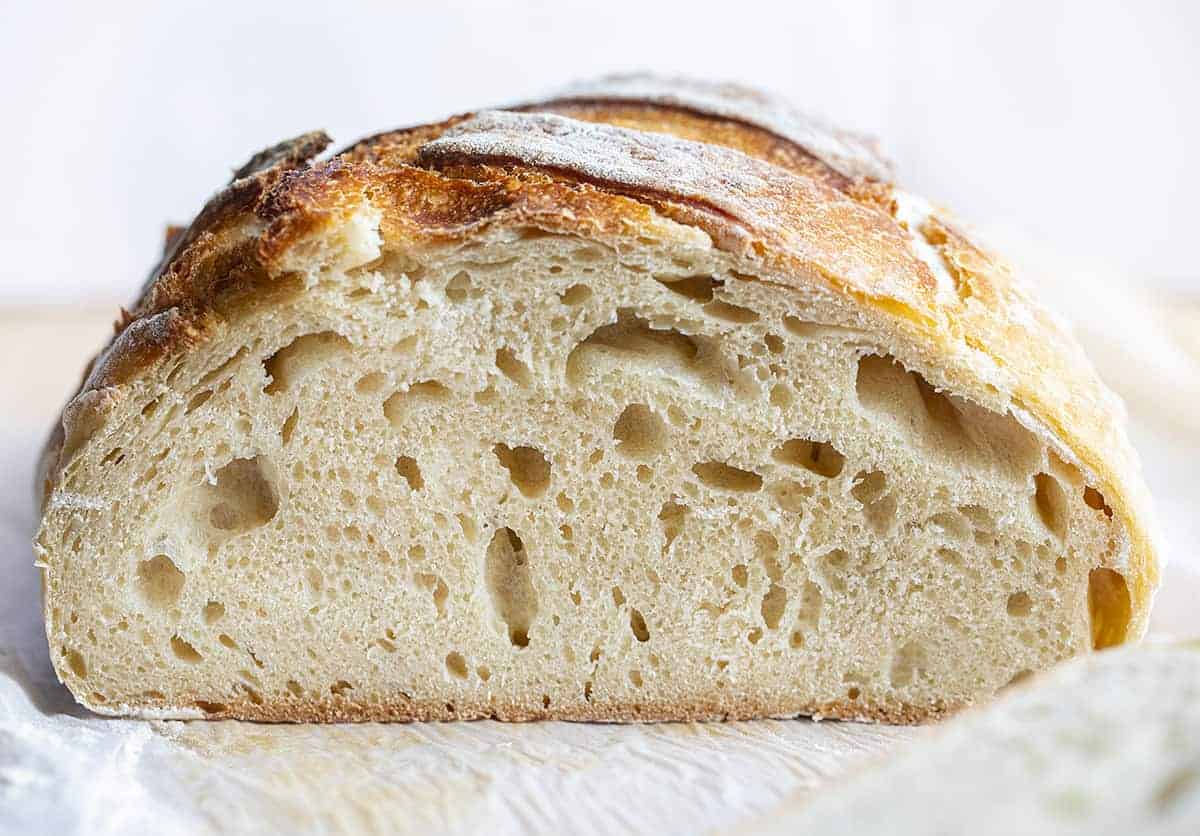
Simple Sourdough Bread Recipe
This Simple Sourdough Bread recipe takes a little patience to let the dough rise a couple of times before baking it. But, if you were patient enough to get your sourdough starter ready to go, then a few hours is nothing! Plus, it is SO worth it to have freshly baked bread! There are only five ingredients to this recipe, so you more than likely have everything you need on hand.
How to Make Simple Sourdough Bread
Get out your stand mixer (or get your muscles ready) to mix the ingredients for the dough.
- Combine all the ingredients together in the bowl from your stand mixer. (Learn how to make a Sourdough Starter here)
- Use the dough hook attachment and mix the ingredients together on medium-low speed (or no higher than a ‘2’ setting). If you are mixing by hand, knead everything together for about ten minutes.
- After you have mixed the dough (it will be sticky), place it in a lightly oiled bowl.
- Cover the dough with plastic and let it sit for about 3 hours to let it rise.
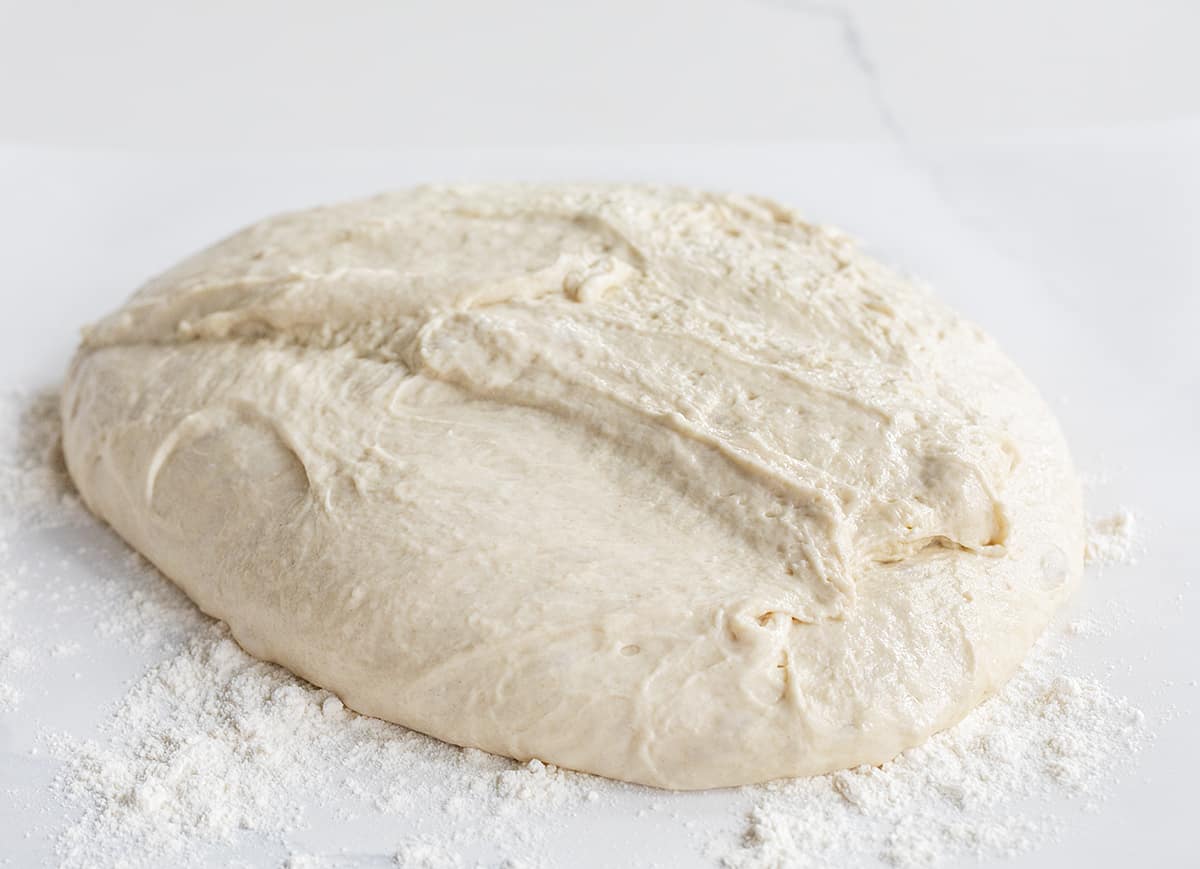
After the dough has had time to rise, gently fold up the sides of the dough, rotate the bowl, and fold again. Continue to do this until you have folded and rotated the dough a few times.
Did you know that using your hands this way and baking bread, in general, is very therapeutic? It involves patience and it can be very calming. Speaking of patience, after folding and rotating the dough, you need to cover it again to let it rise. It may not take the full 3 hours this time; it depends on how warm your kitchen is. Check it after a couple of hours.
After a couple of hours, sprinkle some flour onto your work surface and place the dough on the flour. Pull up the sides of the dough, pressing them into the center. You may need more flour, so keep that nearby! Continue to pull and press for a while. Finally, flip over the dough. The top should be smooth. Sprinkle some flour on it, and place it on a piece of parchment paper.
Once the dough is on the parchment paper, score the dough, or make a few cuts on the top of the dough a few times with a knife.
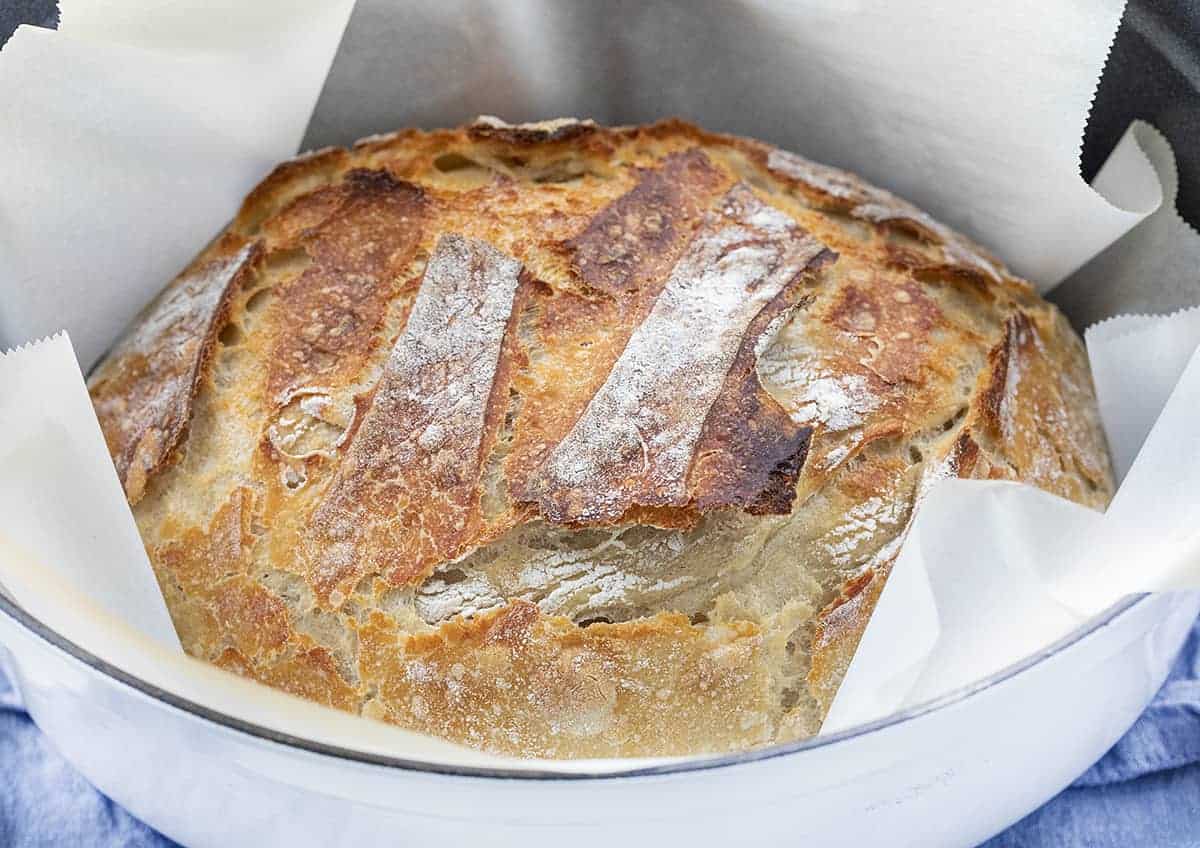
How to Bake Simple Sourdough Bread
Once the dough is on the parchment paper (or you could do this before you pull and press the dough the final time), put a Dutch oven–lid ON–into a cold oven. Set the oven to 450°F to heat up the Dutch oven. Once the oven has reached the temperature of 450°F, carefully remove the hot Dutch oven and take off the lid (setting the lid on the stovetop).
Grab the parchment paper that is holding the dough and place it (again, carefully) into the hot Dutch oven. Cover it, and bake the bread for 15 minutes, with the oven still set at 450°F. After fifteen minutes, remove the lid of the Dutch oven and bake for an additional 10-15 minutes, or until the top is a nice golden brown.
When you tap on the top of the bread, you should hear a hollow sound. Then, you know it is ready to be taken out of the oven. Let it sit for about 20 minutes on the counter or stovetop before taking it out of the Dutch oven and sliced. Enjoy!
How to Store Simple Sourdough Bread
Sourdough bread usually lasts for 4-5 days at room temperature. Do not store it in the refrigerator. Instead, keep it covered with a towel or in a zipped plastic bag someplace that is relatively cool. A bread box also works well. If you want to freeze the bread, be sure to let the bread cool completely before freezing!
The same advice goes for when you are going to cut into the bread–wait until it has cooled. Anyway, to freeze the bread, seal the loaf into a zipped plastic freezer bag, making sure to let all the air out. You can store bread for up to 6 months in the freezer, but the longer you keep it in there, the less fresh tasting it will be. (And be sure to label it with the date!)
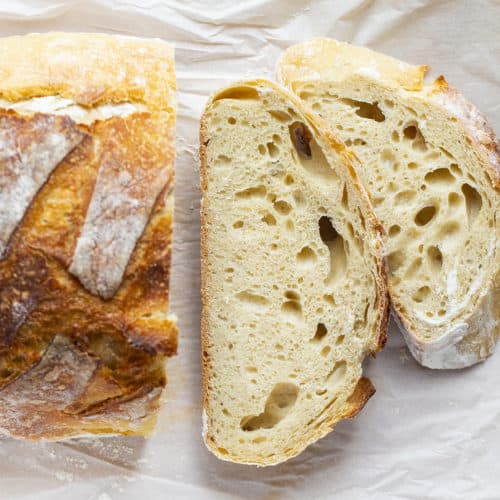
Simple Sourdough Bread
Ingredients
- 4-5 cups (500-625g) all-purpose flour, I prefer unbleached
- 1 1/2 cups (355g) warm water
- 3/4 cup (170g) active sourdough starter
- 1 tablespoon honey
- 1 teaspoon salt
Instructions
- Add all ingredients together in the bowl of a stand mixer with dough hook.
- Turn the mixer on 1-2 (never higher than 2 or medium-low) and let the mixer knead the dough for about 5 minutes. The dough will be sticky and doesn’t quite form a ball. (If making by hand, knead for about 10 minutes.)
- Turn off the mixer and scrape the dough into a medium bowl that has been lightly coated with oil. Cover with plastic and set aside for about 3 hours while the dough rises.
- After 3 hours, turn the dough and gently start folding up the sides. Grab the dough at the side of the bowl and lift up and towards the center of the bowl. Press down, turn the bowl 90 degrees and repeat this several times.
- Cover again and let it rise for an additional 2-3 hours. (This will depend on the temperature of your home. A warmer kitchen will need less time.)
- After the 2 hours, lightly dust your countertop with flour. Press the dough down with your fingers then start pulling up the sides and pressing into the center. You may need to add more flour as this can be a loose dough. Keep pulling up the sides and pressing into the center then flip the dough over. The top should be smooth. Dust with more flour and set the dough onto a piece of parchment paper. Score the dough with a knife.
- Place a Dutch oven (make sure you have a lid) into a cold oven and heat to 450°F. Once heated, carefully remove the hot Dutch oven from the oven. Remove the lid and set it somewhere heat resistant. (I set the lid on my stove.) Pick up the parchment paper with both hands and place inside the Dutch oven. Carefully replace the lid.
- Place into 450°F oven and bake for 15 minutes.
- After 15 minutes, carefully remove the lid and bake an additional 10-15 minutes, or until the top is nicely golden brown (don’t worry if it is darker brown, you just don’t want it burnt) and when you tap on the top the bread sounds hollow.
- Remove from oven and set Dutch oven to the side and leave the bread alone for about 15-20 minutes.
Notes
Did you make this recipe?
Thank you for making my recipe! You took pictures, right? Well go ahead and post them on Instagram! Be sure to mention me @iambaker and use the hashtag #YouAreBaker.
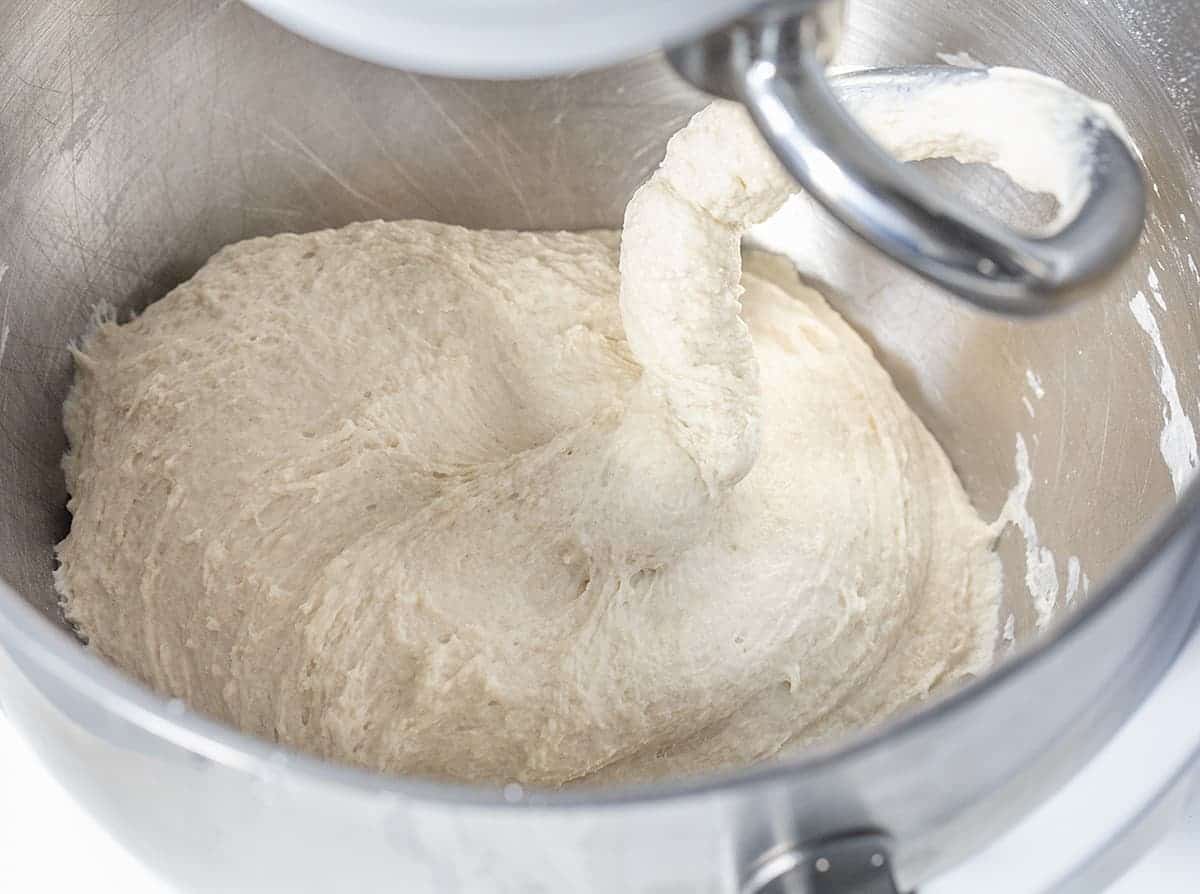
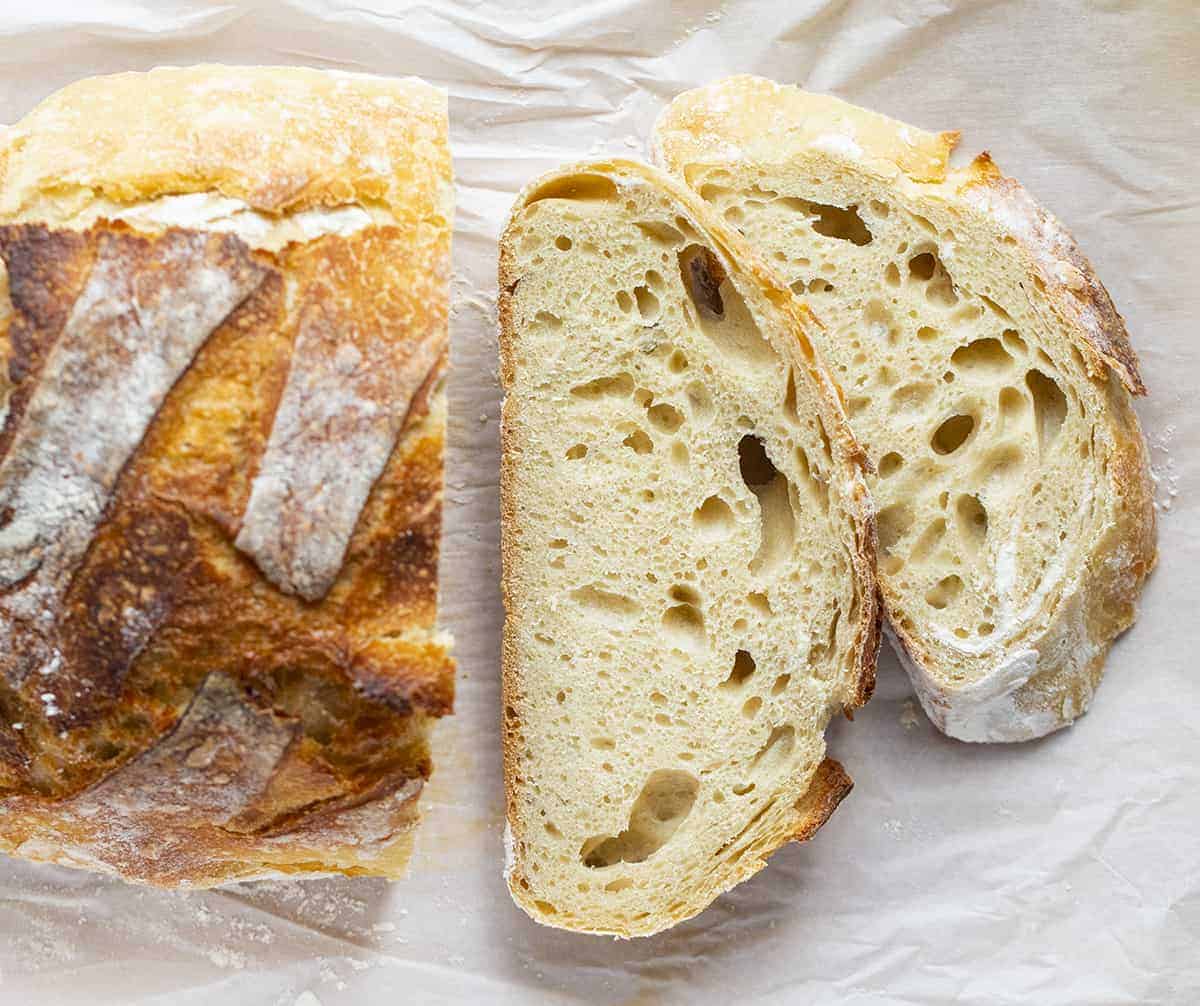











I made this exactly as directed. Not sure if it’s my gas oven or my glass Dutch oven, or both. Anyway the loaf rose and tastes amazing, but not browned on top enough. Bottom is crispy brown. I will be using this recipe again, however I will be increasing my bake time to 25 minutes instead of 15. Love the recipe!
agreed, needing another 10-12 mins, it’s just blond per recipe. I used a cast iron Dutch oven
I totally agree! This needs at least 20 plus minutes lid on and lid off. I love this recipe but I really do think the time needs to be changed. Otherwise it’s burnt on the bottom and damp on the inside. I have my fifth loaf in the oven right now. I’m definitely doing the longer time.
I am a novice
Mine was dough inside maybe because I skipped the leave a lone in Dutch oven 15-20 minutes after baking. Closest I have come trying again tomorrow
Read the directions again. Bake 15 minutes with the lid on. Take the lid off and bake an additional 10-15 minutes. I am not Einstein but I think that computes to a total bake time of 25-30 minutes.
I preheat my oven with my Dutch oven at 450, put my dough in with parchment paper and a few pieces of ice and bake it for 30mins with the lid on. Then remove the lid and bake 15mins mins, my bread always comes out crispy outside and soft and chewy inside. Hope this helps.
Love all of Amanda’s recipes!!
Just starting the process and the time of five min to mix is way off. Not all the flour is mixed and I am scrapping the sides and bottom of the bowl to incorporate. I will get back on the finished product, Fingers crossed
Sounds like too much flour. Did you put all 5 cups of flour in? I start with around 4 1/4 and add more if needed. You can add a little more water and it should come together and be just fine.
I had a neighbor years ago who gave me a frendship/sour dough starter made with instant potatoes, it had a little sweetness to it but was some of the best bread I have ever made. When they moved I forgot to get the full starter instructions but I do know hers had been passed on for many years. Do you have something like that in your collection of yummys?
I had the same starter but have lost the starter. Please send starter recipe if you find it.
https://iamhomesteader.com/sourdough-starter/
Thank you!
I used your recipe but nothing seems to be rising. My 6 day starter seemed sluggish so I fed night before. It had bubbles. The dough looks beautiful. I’m wondering if it will double in rising?
And what does refrigerating the dough before baking do? If I choose to refrigerate and bake in am, how long should it bake?
Thank you again!
Thank you!
I used your recipe but dough does not seem to be rising. My 6 day starter seemed sluggish so I fed night before. It had bubbles. The dough looks beautiful. I’m wondering if it will double in rising?
And what does refrigerating the dough before baking do? If I choose to refrigerate and bake in am, how long should it bake?
Thank you again!
Great recipe! I’m wondering if I can put it in the fridge overnight and when to do it? Thank you!
Can this be baked in a loaf pan?
Are the temperatures standard oven or fan oven, it would be good to say
What are you meaning by “fan” oven?
Our ovens have both Fan (which blows hot air around the oven, so you can reduce the temp, and gives you an even bake)or No Fan just plain heated oven.!!
I think “fan” refers to a convection oven. Convection ovens circulate (fan) the air to ensure even cooking and a crisper crust on breads. Usually, if the recipe calls for a 450 F oven, and you are using convection, you can set the temperature for about 25 F less and cook/bake for less time….. every oven is different, so experimentation is important. In mine, for example, if I am using this recipe and setting the oven to “convection”, I would set the temperature at 425 F and bake it for 15 mins in step 1 and 10 mins in step 2 (being sure to watch it carefully at step 2. Hope this helps.
I understand but it is the person asking the question that needs to clarify, as they could have a very different interpretation of the word.
I hear you Amanda, but noticed that the “person asking the question” did not/has not clarified….
Ok wish me luck am going to try this now. I will post how it goes. I have read all comments so I know what took for as well. Kerry🥰
I have made this twice now (with very few changes). Both times, the result was very good. i was a tiny bit disappointed in the colour/crustiness of the bread…. it was a little “blond” (blonder the first time after 12 minutes from removing the lid, and a little darker the second time after baking it 18 minutes after removing the lid), but the crumb was excellent. I used a cast iron dutch oven, heating it to 450 F as per the instructions, before placing the sour dough into the preheated dutch oven. I think I may bake another batch…. next time, I think I will bake it for 20 – 25 minutes after removing the dutch oven’s lid….. just to brown it a little more. Ovens vary, so does sour dough 🙂 I wish I could include a photo of the end result! Happy baking!!
easy and fast.